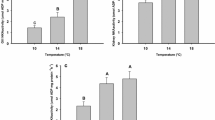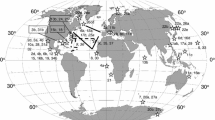Abstract.
Activities and characteristics of two metabolic key enzymes, citrate synthase (CS) and pyruvate kinase (PK), were studied in the Northern krill, Meganyctiphanes norvegica, with respect to adaptive properties under different thermal conditions. Krill were sampled during late winter/spring and summer from the constantly warm Ligurian Sea (12–13°C below the thermocline), the colder but also comparatively constant Clyde Sea (7–8°C), and the variable Kattegat (2–16°C). Both enzymes showed distinct tissue- and organ-specific activities, which were highest in the pleopods – the principal locomotive organs. The fourth and fifth abdominal segments, however, were used for routine investigation due to lowest variability. Specific activity of CS and PK did not differ between seasons in krill from the Kattegat or the Clyde Sea. In the Ligurian Sea, in contrast, specific CS activities were significantly lower during summer. Analysis of individual data illustrated a decrease of CS activity with size and an increase of PK activity with size. Taking these allometric effects into account, as emphasized by calculating the ratio between both enzymes, variation of CS and PK activities turned out to be solely dependent on body size, which differed between locations and seasons. Ligurian krill from the summer, however, were unique in that they showed a lower CS/PK ratio than would be predicted by the scaling effect. Thermal characteristics of each enzyme were similar between locations and seasons. During the winter, in Kattegat and Clyde Sea krill, K m values (Michaelis–Menten constant) of CS towards acetyl-coenzyme A exhibited an almost constant level over the experimental temperature range of 4–16°C. During summer, however, K m values were lower at 8°C in the Clyde Sea and at 12°C in the Kattegat. In Ligurian krill from the summer, K m values were consistently lower than those of winter krill over the entire experimental temperature range. In conclusion, Kattegat and Clyde Sea krill show only minor adaptations to their respective thermal environments in terms of CS and PK characteristics. Ligurian krill, in contrast, exhibited decreased specific CS activity during summer, which might be compensated by elevated enzyme–substrate affinity as indicated by lower K m values. Since temperature was constant during both seasons, this effect cannot be explained as a reaction to thermal conditions. Consequently, oligotrophic conditions in the Ligurian Sea during summer may entail a reduction in the somatic performance of krill, which is reflected by lower CS activity.
Similar content being viewed by others
Author information
Authors and Affiliations
Additional information
Electronic Publication
Rights and permissions
About this article
Cite this article
Saborowski, .R., Buchholz, .F. Metabolic properties of Northern krill, Meganyctiphanes norvegica, from different climatic zones. II. Enzyme characteristics and activities. Marine Biology 140, 557–565 (2002). https://doi.org/10.1007/s00227-001-0734-0
Received:
Accepted:
Issue Date:
DOI: https://doi.org/10.1007/s00227-001-0734-0




